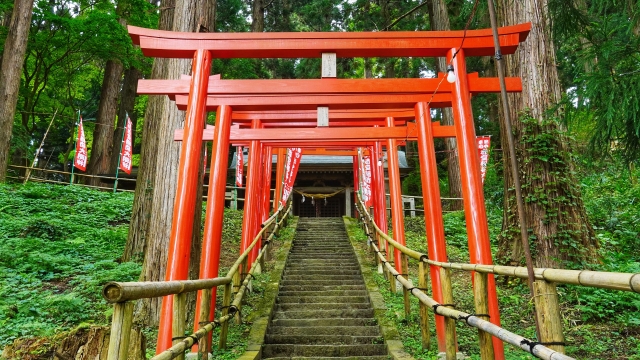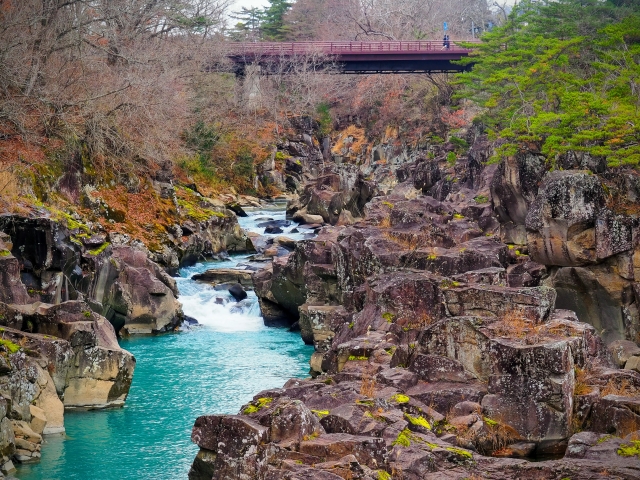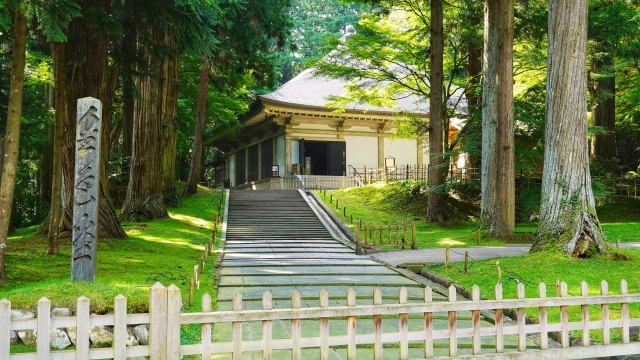Chūson-ji Temple, Iwate: A Blissful Journey Through Japan’s History and Beauty

The Charm of Chūson-ji Temple
Located in Hiraizumi Town, Iwate Prefecture, Chūson-ji Temple is a special place where you can deeply feel Japan’s history and culture. Founded in the 12th century by the Northern Fujiwara clan, Chūson-ji boasts numerous national treasures and important cultural properties. The temple grounds are beautifully adorned with nature in every season, offering visitors a sense of tranquility. The most famous attraction, the Konjikidō (Golden Hall), captivates many tourists with its opulent decorations and historical significance.
Access
Accessing Chūson-ji Temple is relatively straightforward from major airports. Here’s how to get there from Narita Airport, Haneda Airport, and Kansai International Airport.
From Narita Airport
To reach Chūson-ji Temple from Narita Airport, first travel to Tokyo Station, then take the Tōhoku Shinkansen. Take the Narita Express to Tokyo Station, then transfer to the Tōhoku Shinkansen “Yamabiko” or “Hayabusa” and get off at Ichinoseki Station. From Ichinoseki Station, it’s about a 30-minute bus ride or a 20-minute taxi ride to Chūson-ji.
From Haneda Airport
From Haneda Airport to Chūson-ji Temple, first travel to Tokyo Station or Ueno Station and then take the Tōhoku Shinkansen. Take the monorail to Hamamatsuchō Station, then transfer to the JR Yamanote Line to Tokyo Station or Ueno Station. Board the Tōhoku Shinkansen and get off at Ichinoseki Station. From there, follow the same route as from Narita Airport, taking a bus or taxi to Chūson-ji.
From Kansai International Airport
From Kansai International Airport to Chūson-ji Temple, first travel to Osaka Station and then take a flight or Shinkansen via Tokyo or Sendai. From Osaka Station, head to Itami Airport or Kansai International Airport and take a flight to Sendai Airport. From Sendai Airport, take a train to Sendai Station and transfer to the Tōhoku Shinkansen to Ichinoseki Station. From Ichinoseki, take a bus or taxi to Chūson-ji.
Highlights of Chūson-ji Temple

Konjikidō (Golden Hall)
The most famous building in Chūson-ji, Konjikidō, is a golden hall built in the 12th century to showcase the power of the Northern Fujiwara clan. The interior is covered in gold leaf and filled with luxurious carvings and ornaments. Designated as a national treasure, Konjikidō is a treasure trove of Buddhist art, making it a must-see for its beauty and historical value.
Chūson-ji Main Hall
The main hall of Chūson-ji, located at the center of the temple grounds, is a large Buddha hall visited by many worshippers. Inside the main hall, numerous Buddhist statues and artworks are enshrined, offering a serene atmosphere for prayer. The hall is especially recommended for visits in spring, when cherry blossoms bloom, and in autumn, when the foliage is stunning.
Chūson-ji Museum
To gain a deeper understanding of the history and culture of Chūson-ji, a visit to the Chūson-ji Museum is essential. The museum displays materials related to the Northern Fujiwara clan, information on the temple’s buildings, and various Buddhist artworks. Through the exhibits, you can learn about the historical background and cultural value of Chūson-ji.
Nearby Attractions
Mōtsū-ji Temple
Located close to Chūson-ji, Mōtsū-ji Temple is another wonderful place to experience the history of Hiraizumi. Mōtsū-ji is known for its beautiful garden and historical buildings, particularly the Pure Land Garden. Enjoy a peaceful stroll in this serene environment.
Hiraizumi Cultural Heritage Center
The Hiraizumi Cultural Heritage Center is a museum that introduces the history and culture of Hiraizumi. Visiting this center before heading to Chūson-ji or Mōtsū-ji will provide a deeper understanding of these temples’ historical and cultural contexts. The center features exhibits and video materials that comprehensively showcase Hiraizumi’s charm.
Genbikei Gorge

A bit further from Chūson-ji, Genbikei Gorge offers breathtaking natural scenery. It is famous for its beautiful gorge views and unique flying dango (rice dumplings) that can be enjoyed. Refresh yourself in nature while savoring delicious dango.
Conclusion
Chūson-ji Temple in Iwate Prefecture captivates many with its history and beauty. Its excellent accessibility makes it easy to visit, and combining a trip to Chūson-ji with other Hiraizumi attractions offers a deeper experience of history and culture. Through a visit to Chūson-ji, fully enjoy the history and beauty of Japan.

